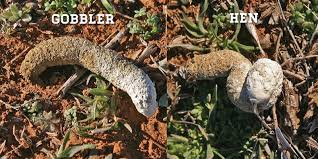Who's Scat is That? A Study on Turkeys
If you follow our social media accounts you probably see that once in a while we post a "Who's scat is that?" quiz. It is a fun way to get the public involved- I sure love trivia- but it is also a really useful tool in identifying what animal has been around.
Turkeys. That's what I want to tell you about today and this is more than a post about poop. A lot goes into identifying turkeys and habitat requirements are really cool, too. With turkeys, you can tell by their scat if it's a male or female.
Photo from Great Plains Nature Center
Turkey scat has a gradient of brown to white in color. But here is where it gets different, male turkeys just have a "J" shaped poo and females have a curled poo, kind of in a "?" shape.
Kim Smith Designs created this photo
Then jakes (young turkeys) vs. toms (mature adults) have things that are different, too. Jakes just don't have as long of spur or beard as toms and also they are actively replacing their tail feathers for their adult ones, that starts in the middle and works it's way toward the outside ends. When birds lose their feathers it is typically balanced so during flight they can still steer evenly.
Turkeys basically utilize all habitat types: agriculture, woods and fields (grasslands). If you think about roosting trees are needed. Here in the UP we have no shortage of that but areas in the US without much trees they have been known to roost on telephone poles. Woods are also good for cover requirements for nesting with canopy cover and understory cover (brush piles and bushes). Fields and grassland areas are great for brooding because the young turkeys need a lot of protein to grow. Grasslands have a lot of insects to meet that and can be great cover as well with the grass, but they don't seem to like very tall grass very much because they still want to see any potential predators. Agriculture fields are great as well because of the grains and insects they have. Then in the Fall and Winter they return back into the forests for cover, wind/weather breaks, and mast for food.
Turkeys are pretty abundant in my area of the Western UP. I hope you see some and put this information to good use!







.png)
Comments
Post a Comment